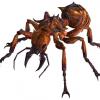So, I went to where there are a lot of Pogonomyrmex subnitidus colonies (they are along a part of the river, but toward the top of it) and managed to find a small colony under a rock. I assume that is what they are, as Drew as a lot of them marked around my area on his ant map and they look like mine. I got about 75 ants or so (it was a pretty small colony) and the queen. Only one larvae, as they had no other brood. I am guessing they just woke from hibernation, as I went down a week ago and there wasn't any out.
They are in the formicarium I bought from Drew the other week, and I included a little bit of the substrate they were nesting in. From my understanding, Pogonomyrmex like having substrate to move...so I included a very thin layer of sand to it.
And as I always do with my ants when I first get a queen or colony. I gave them a couple drops of honey (which they ate really quick) and I crushed up quinoa which they took into part of the formicarium. So, now they have a granary already and I just got them. Usually when I get Pogonomyrmex, they don't tend to eat much...so very good sign.
Will definitely take pictures of it, as Drew's formicarium really is great. I had Crematogaster in there before, but they were too small and I moved them to something else. But, the Pogonomyrmex go great with it. Its a lot better than substrate nests in containers, as I can actually see their brood pile(s) grow and they don't "disappear" into the dirt like my ants usually do. A lot less messy looking too.
By the way, don't get stung by these ants (or most/all other Pogonomyrmex ![]() ) last year I had around 15-20 total stings from them over the year. One time I was getting them, I had around 7-8 stings and my whole hand started spazzing out and I couldn't move my fingers at all for a good minute. They have a VERY painful sting.
) last year I had around 15-20 total stings from them over the year. One time I was getting them, I had around 7-8 stings and my whole hand started spazzing out and I couldn't move my fingers at all for a good minute. They have a VERY painful sting.
This species also seems resistant to Argentine ants...the Argentine ants either don't attack them or the Argentine ants can't get into their nests for whatever reason. There are billions of Argentine ants below them in the river (about 6 feet down), but the Pogonomyrmex survive year after year I guess. Could be its too dry on top (the river goes through a canal with concrete on both sides, but there is a lot of plant areas in the canal and on top is drier) so the Argentine ants don't bother going up to where they are. In any case, they don't seem to be bothered much by the Argentine ants.
Edited by Vendayn, April 9 2015 - 9:13 AM.

















